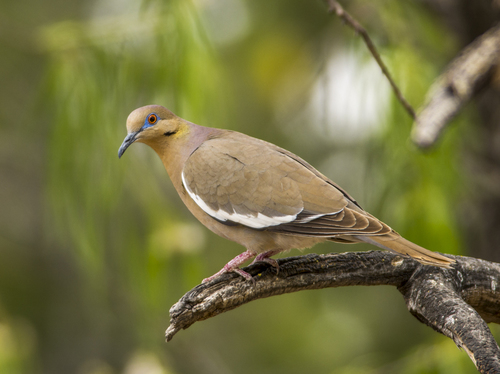
White-winged Dove
The White-winged Dove (Zenaida asiatica) is a distinctive dove species known for its prominent white wing patches, visible both in flight and at rest. It plays a significant ecological role as a seed disperser, particularly in arid and semi-arid environments of North and Central America. It has also become a popular game bird in some regions. Culturally, the dove's gentle cooing and association with peaceful habitats have made it a familiar and often welcomed sight in both rural and urban settings.
29-31 cm
Length
48-58 cm
Wingspan
Least Concern
Conservation Status
Distribution
Southwestern United States through Mexico, Central America, and the Caribbean. Some populations are migratory, moving north into the US to breed, while others are resident year-round. They have also expanded their range in recent decades, moving further north and east in the US.
Lifespan
In the wild, the average lifespan is relatively short, often only a few years. In captivity, they can live longer, potentially up to 10 years or more, although this is less common.
White-winged Dove's Habitat
Habitat Types
Deserts, Scrublands, Woodlands, Urban areas, Agricultural fields
Climate Zones
Arid, Semi-arid, Subtropical, Temperate
Adaptations
White-winged Doves are well-adapted to arid environments. They can tolerate high temperatures and obtain much of their water from their diet, primarily seeds and fruits. They can also utilize a variety of habitats, contributing to their range expansion.
Variations
There are several recognized subspecies, differing slightly in size and plumage coloration. For example, the *Zenaida asiatica mearnsi* of the southwestern US and northwestern Mexico is larger and paler than the *Zenaida asiatica asiatica* found in eastern Mexico and Central America.
Appearance
Breeding Plumage
Plumage is generally consistent year-round, with no significant differences between breeding and non-breeding seasons.
Seasonal Feather Changes
None
Sex Based Plumage Differences
Males and females have very similar plumage. Males may have a slightly more pronounced purplish wash on the head and neck, but this is often subtle.
Notable Features
Prominent white wing patches, Blue orbital ring (skin around the eye), Black streak below the eye, Rounded tail with white corners
Diet and Feeding
Primary Foods
Seeds, Grains, Fruits, Occasionally insects
Foraging Behavior
White-winged Doves primarily forage on the ground, often in flocks. They walk and peck at seeds and other food items. They are also known to visit bird feeders, particularly those offering grains and seeds.
Specializations
They have a relatively large crop, an expanded part of the esophagus, which allows them to store seeds temporarily before digestion. This is an adaptation for feeding in areas where food may be abundant but scattered.
Seasonal Diet Variations
Their diet can vary depending on the availability of food. During the breeding season, they may consume more fruits and insects to provide protein for developing chicks. In the winter, they rely more heavily on seeds and grains.
Behavior
Social Structure
White-winged Doves are often found in flocks, especially outside of the breeding season. During the breeding season, they may be more territorial, defending nesting sites.
Communication
Cooing vocalizations (a distinctive "hoo-hoo-hoooo"), Wing-whistles during flight, Bowing and preening during courtship
Migration
Some populations are migratory, particularly those breeding in the northern parts of their range. They migrate south for the winter, often in large flocks. The timing and extent of migration can vary depending on weather conditions and food availability.
Territorial or Group Behaviors
During the breeding season, males defend territories around nesting sites. Outside of the breeding season, they are generally more social and form flocks, sometimes numbering in the thousands.
Conservation
Threats
Habitat loss (due to agriculture and urbanization), Hunting (in some regions), Pesticide exposure, Climate change (potentially affecting food availability and breeding success)
Protection Programs
Migratory Bird Treaty Act (in the US), Monitoring of populations by state and federal agencies, Habitat conservation and restoration efforts in some areas
Local National Laws
Protected under the Migratory Bird Treaty Act in the United States. Hunting regulations vary by state and country.
Population Trend
Stable
Population Estimates
The global population is estimated to be around 9 million birds.
Interesting Facts
They are known for their rapid range expansion.
Over the past few decades, White-winged Doves have expanded their range significantly northward and eastward in the United States, likely due to a combination of factors, including climate change, increased availability of food sources (such as agricultural fields), and their adaptability to urban environments.
They can drink brackish water.
Unlike many other bird species, White-winged Doves have some tolerance for salt in their drinking water, allowing them to utilize water sources that other birds might avoid.
They are important seed dispersers.
By consuming fruits and seeds and then moving to different locations, White-winged Doves help to spread plants, particularly in arid and semi-arid environments.
Faqs about White-winged Dove
What is the difference between a White-winged Dove and a Mourning Dove?
White-winged Doves have prominent white wing patches, a blue eye-ring, and a shorter, more rounded tail compared to Mourning Doves. Mourning Doves have pointed tails with white spots, and lack the white wing patches and blue eye-ring.
Are White-winged Doves aggressive?
They can be territorial during the breeding season, defending their nesting sites from other doves. However, they are generally not aggressive towards humans and are often seen in close proximity to people.
What can I do to attract White-winged Doves to my yard?
Provide a source of fresh water, such as a birdbath or shallow dish. Offer grains and seeds, such as millet, sunflower seeds, and cracked corn, in a ground feeder or platform feeder. Planting native trees and shrubs that provide food and shelter can also attract them.
Copyright @ Nature Style Limited. All Rights Reserved.
 English
English